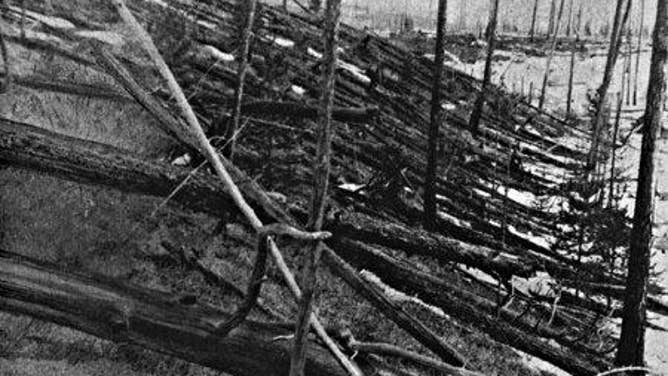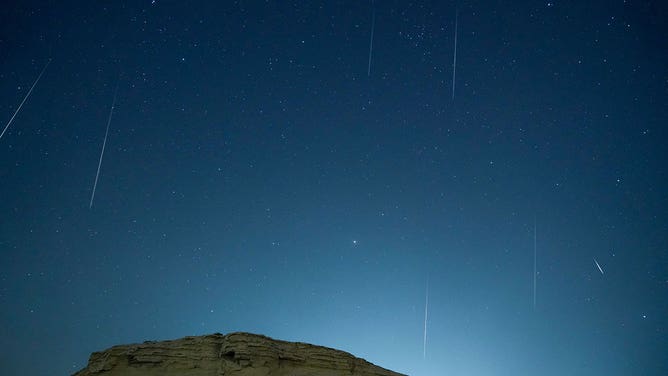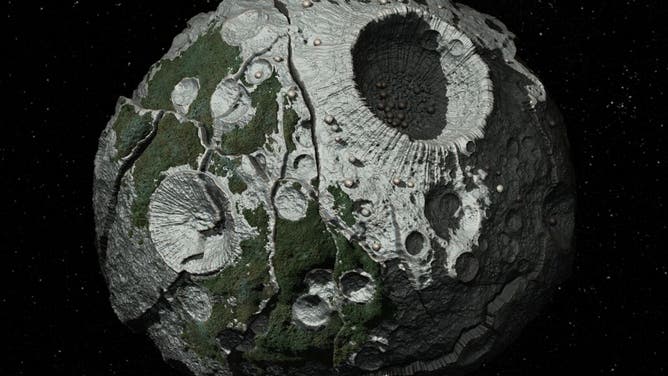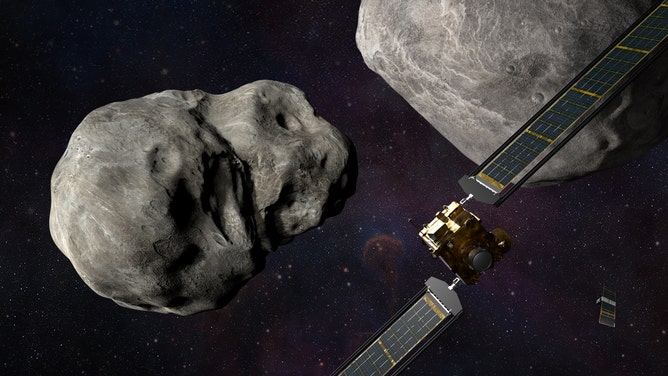Deep impact: What to know about asteroids and when we should be worried about them
Asteroid scientists and astronomers are actively tracking asteroids making a 'close' approach to Earth
Learning the history of asteroids on World Asteroid Day
Maxime Devogele, Observatory Scientist at Arecibo, helps us to understand more about asteroids on World Asteroid Day.
More than 1.1 million asteroids have been identified, and while that number may sound terrifying, only a small number will ever come close to Earth. Those near-Earth asteroids are the ones we want to know more about.
As the leftovers of our early solar system, asteroids contain clues about how our planets formed. Scientists at NASA and international organizations are studying asteroids with telescopes and spacecraft to better understand how to protect Earth from one and solve unanswered questions about how we got here.
HOW TO WATCH FOX WEATHER ON TV
In honor of World Asteroid Day on June 30, here are some interesting facts about asteroids, including how we'll know when we should be concerned about a potential impact.
The history behind World Asteroid Day

Trees felled by the Tunguska explosion. (Image Credit: the Leonid Kulik Expedition/NASA)
On June 30, 1908, a 160-foot-wide asteroid impacted a remote area in Tunguska, Russia.
According to NASA, the blast from the asteroid was felt 40 miles from ground zero. An estimated 80 million trees were knocked over in the Siberian outback and the seismic shockwave registered as far away as England.
The impact was so intense the explosion knocked a man off his chair in Vanavara, Siberia.
No one was injured because the region is mostly uninhabited. However, if the impact had happened in a large city, the damage would have been widespread, with many injuries.
A much smaller 55-foot asteroid exploded over Chelyabinsk, Russia, in 2013 and people were injured from shattering glass, explained Arecibo Observatory Asteroid Scientist Maxime Devogele.
HOW ASTRONOMERS KNEW EXACTLY WHERE A SMALL ASTEROID WOULD IMPACT EARTH
"They were looking at the meteor actually from windows, and their windows like blew up with the waves," Devogele said. "So many people were injured. Nobody was killed, but many people were injured. So it's important to know about these events before they arrive."
The Tunguska event remains the only modern-day significant meteoroid impact with first-hand accounts.
In 2016, the United Nations declared June 30 World Asteroid Day in an effort to raise awareness about asteroid impacts and planetary defense.
There are different kinds of asteroids
Asteroids are mostly classified into three major groups.
Most known asteroids come from the Main Asteroid Belt between Mars and Jupiter. According to NASA, an estimated 1.1 and 1.9 million asteroids larger than .6 miles are located in the belt. The belt also continues millions of smaller asteroids. These asteroids formed early in the solar system as small bodies collided, fragmenting them into what are now asteroids.
Trojan asteroids share an orbit with a large planet and are separated into two groups. The largest group is the Jupiter trojans.
Associated with Jupiter because the Trojan asteroids are on the same orbital path, there are two groups of Trojan asteroids, one zooming ahead of Jupiter and another set trailing behind the gas giant. In October, NASA launched the Lucy spacecraft to study the group of objects.
There are also Mars and Neptune trojans, according to NASA.
The third type of asteroids are the ones Earthlings should want to know the most about, asteroids passing near Earth. Read on below for more about near-Earth asteroids.
How many Near-Earth asteroids are there?
NASA's Planetary Defense Coordination Office uses ground-based telescopes to look for asteroids. While about 27,000 near-Earth asteroids have been identified, more are still out there. According to NASA, about 40% have been identified.
Even the term "near" is relative in the context of space. A near-Earth object (NEO) is anything within 30 million miles of Earth. If it comes within 5 million miles, that's when NASA begins tracking it. That is considered a potentially hazardous asteroid.
NEOs range from 10 feet to nearly 25 miles across.
For example, a house-sized asteroid (2022 MB3) will make the closest approach on July 1, but it will still be 483,000 miles from Earth or more than twice the distance between the Earth and the moon.
You can track the next asteroid close approach to Earth here.
Tiny asteroids hit Earth all the time

A meteor streaks across the night sky in Bazhou, Xinjiang Province, China, in the early morning of December 14, 2021.
(Xue Bing / Costfoto/Future Publishing via Getty Images)
An asteroid creates meteors as the space rocks enter Earth's atmosphere. Tiny meteors about an inch in diameter are hitting Earth all the time but don't cause any harm.
According to NASA, 80 to 100 tons of material falls on Earth from space from dust and meteorites.
NASA'S SPACECRAFT WILL RENDEZVOUS WITH RARE ASTEROID COMING CLOSE TO EARTH
Large asteroids like the Tunguska or Chelyabinsk events are much rarer.
Devogele estimates large impacts that can cause damage happen every few decades or even a hundred years, like the Tunguska event.
Why it's important to identify and track asteroids

This artist’s conception shows a close-up of the Psyche asteroid. Image (Credit: Peter Rubin/ASU/NASA)
There are many types of asteroids. Some are rocky, while others are mostly made of metal elements.
Understanding an asteroid's composition is important to know what will happen when it hits another world, including Earth.
"It's very important to understand all that will affect the atmosphere and all that will affect if they reach the ground," Devogele said. "Every scenario results in a different impact on the ground."
Asteroids are considered fossils of our solar system because they are the leftovers from when the planets formed about 4.6 billion years ago.
Devogele said asteroids provide clues to better "understand the history of the solar system, how the solar system formed … or how all life evolved on the Earth."
NASA's Center for Near-Earth Object Studies characterizes the orbits of NEOs and predicts their orbital trajectory, including if they will make a close approach to Earth.
NASA is testing a way to deflect asteroids

Illustration of NASA’s DART spacecraft and the Italian Space Agency’s (ASI) LICIACube prior to impact at the Didymos binary system. Credit: NASA/Johns Hopkins APL/Steve Gribben
(NASA)
A small NASA spacecraft called DART is currently en route to crash into a small asteroid moonlet orbiting a larger asteroid. This intentional smack is designed to see if the kinetic energy can change the direction of the moonlet a tiny bit.
After launching in November, the spacecraft continues to travel to the asteroid Didymos and its smaller orbiting asteroid Dimorphos. DART will arrive in September or October 2022.
7 THINGS TO KNOW ABOUT NASA’S DART MISSION
If DART hits Dimorphos at 15,000 mph as planned, this is the best way to test the kinetic impactor Earth defense theory.
"The point of a kinetic impactor is you ram your spacecraft into the asteroid you're worried about, and then you change its orbit around the Sun by doing that," Johns Hopkins Applied Physics Laboratory Planetary astronomer Andy Rivkin told FOX Weather in November.
Scientists using ground-based telescopes will be able to monitor any change, and later another spacecraft will visit Didymos to study the impact site.
If this works, the idea is to apply the same technique to larger asteroids.
‘Armageddon’ plot is not Earth's best defense
If an asteroid the size of Texas were coming toward Earth, NASA would know years in advance, not just two weeks like in the science-fiction thriller "Armageddon."
According to NASA's Planetary Defense Coordination Office, shooting down an asteroid is not an option.
CLICK HERE TO GET THE FOX WEATHER UPDATE PODCAST
"An asteroid on a trajectory to impact Earth could not be shot down in the last few minutes or even hours before impact. No known weapon system could stop the mass because of the velocity at which it travels – an average of 12 miles per second," according to NASA.
Blowing up an asteroid would also not be a good plan because it would create a lot more asteroids of various sizes on different trajectories.
The best time to deflect an asteroid is as far away from Earth as possible.
